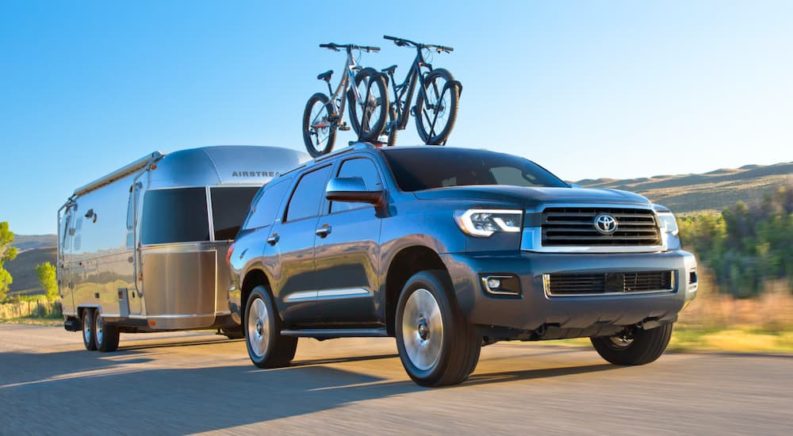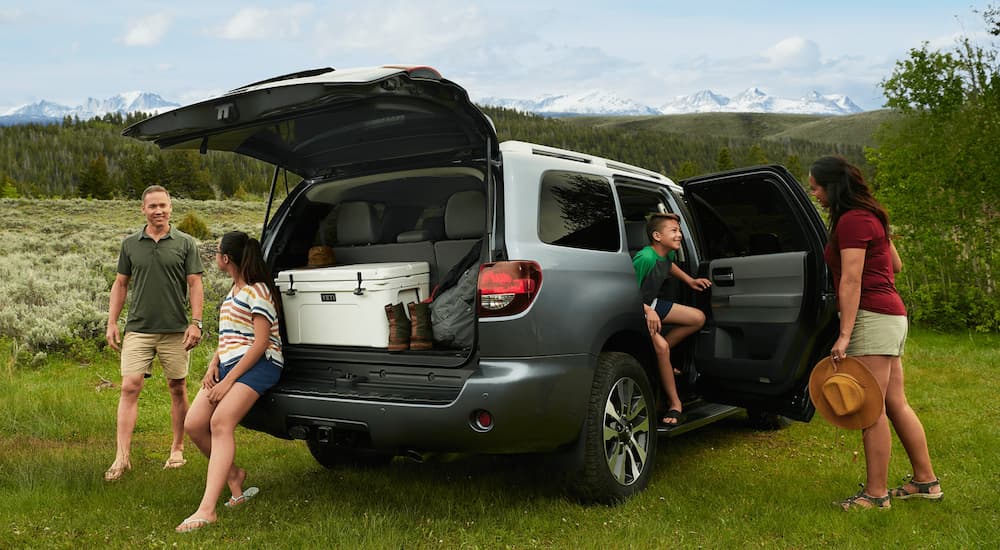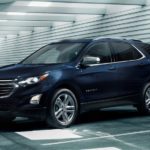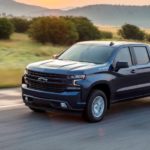When you need a large family vehicle to transport a lot of people and cargo, you’re looking for a three-row vehicle. You have one of two options: a minivan or an SUV. Toyota makes one of each with the 2021 Toyota Sienna minivan and the 2021 Toyota Sequoia SUV. Both have seating for either seven or eight passengers, a roomy interior with seating that accommodates adults in all three rows, and plenty of technology to keep everyone entertained while you travel. Which vehicle is best suited to your family may come down to details like whether or not you intend to tow a trailer for family vacations or you want easy access with little ones and all the supplies you need to haul with you. Here is a look at the features of each vehicle to give you a sense of which one is best for your needs.
Capability and Fuel Efficiency
Everything starts with the type of engine you find under the hood. Toyota puts a fairly powerful V8 engine into the 2021 Sequoia that comes standard as rear-wheel drive with the option to add four-wheel drive on any trim. It has the capability to tow up to 7,400 pounds, and Toyota thoughtfully gives the Sequoia standard tow hitch equipment, so you don’t have to purchase a package. The V8 is the only engine option across all the trims, including the two sport-oriented models available. However, this only means that across the lineup, you gain the type of power that might be reserved for the more expensive trims in other trucks. One downside of having such a powerful engine is the fuel efficiency, but if you need the power, the Sequoia is a great option.
In comparison, the 2021 Sienna minivan now comes standard with a hybrid powertrain, which is the only option. The powertrain is a combination of a gas-powered four-cylinder engine and a pair of electric motors that work together to move the Sienna with standard front-wheel drive. Don’t let the hybrid scare you away; you won’t have to plug it in or worry about running out of charge because the gas-powered engine takes care of that.
You can treat this hybrid like a gas-powered vehicle that gets great fuel efficiency. In fact, you get an excellent 36 miles per gallon in all driving situations, a figure which is only slightly affected when you add the all-wheel drive, which is available on any trim. A bonus with the 2021 Sienna is that it can also tow up to 3,500 pounds, though a downside is that a towing hitch is not included.
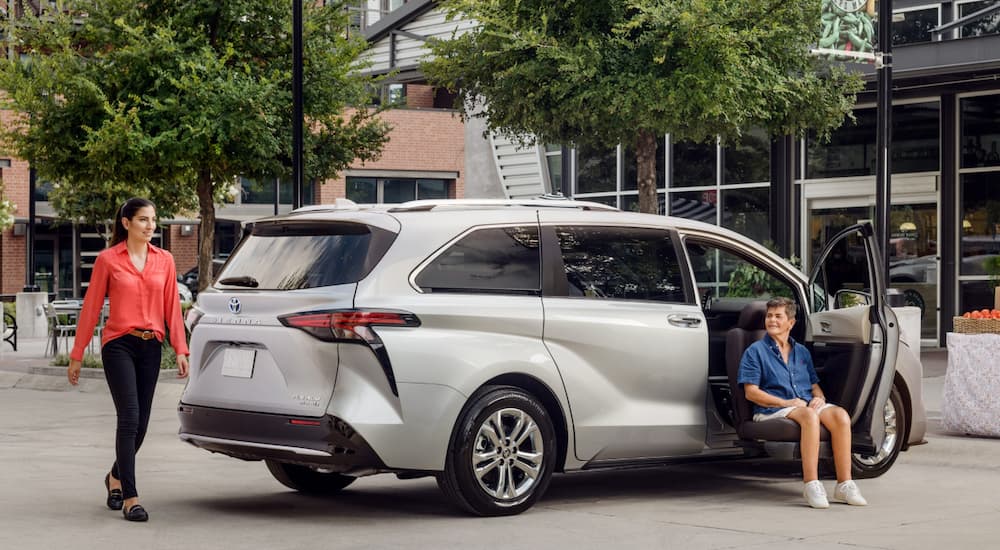
Interior Space and Conveniences
When you have a large number of people to take on errands or long trips, it matters whether or not the space accommodates both people and cargo. Large families, especially with very small children, have a lot of stuff to transport, and it makes a difference when your vehicle has the right kind of space to keep it all organized. What’s great about both the 2021 Sequoia and 2021 Sienna is that the legroom in each vehicle is fairly generous, which makes them both comfortable for people of any size – even adults – in all three rows of seats.
The Sequoia’s measurements for legroom breaks down to 42.5 inches in the front, 40.9 in the second row, and 35.3 inches in the third row. For the Sienna, the measurements are 40.3 inches in the front, 39.9 in the second row, and 38.7 for the third row. In general, the SUV has a larger front row, while the third row in the minivan is bigger. If you need to transport adults or tall teens in the back, the Sienna will be the better option for comfort, but if you’re a tall driver, the SUV will be better.
Cargo Space in both vehicles is also excellent, with the Sequoia boasting a maximum capacity of 120.1 cubic feet of total space with all the seats folded flat. The Sienna has less total space with the seats folded at 101 cubic feet, and it does have the drawback of needing to take the second row of seats out to utilize the full capacity of the interior for cargo. With that said, if you plan to travel with kids most of the time, you probably will have the seats in place and will need the room for your cargo in the rear trunk area.
Both vehicles have fold-flat rear seats, though the Sienna’s seats stow in the floor. This makes the rear cargo area larger when the seats are in use, and it gives more storage space at 33.5 cubic feet compared to the Sequoia’s 18.9. Folding down the third row opens up to 75.2 cubic feet for the Sienna and a comparable 66.6 for the Sequoia.
How this all truly works in daily life may boil down to how you plan to use the vehicle. If you have children who need strollers, ride in a booster or baby seats, and need a lot of extra clothes or toys when you travel, the minivan may be the better choice. Loading a stroller into the rear area of the Sienna will be easier with a lower load floor, and getting your kids in and out of the vehicle will be easier with the sliding side doors. If you have older kids who need less stuff, the SUV should be fine for daily transport, especially if you take family vacations with a larger camper or boat and expect to travel in more remote locations. The Sequoia comes standard with roof rails to accommodate a rack for more cargo in case you need that, equipment which is optional for the Sienna.
Entertainment and Technology
When you need to keep your family entertained to maintain sanity for either daily errands or long trips, having technology in your vehicle can make all the difference in the world. Toyota gives both the 2021 Sequoia and 2021 Sienna a lot of standard technology to connect devices, including the option to have a rear-seat entertainment system. Standard equipment like Apple CarPlay and Android Auto for both vehicles makes pairing your smartphone with the infotainment automatic once you set it up. You also have the advantage of Toyota’s connected service, called Safety Connect, which hooks you up with a one-year trial period for services that include WiFi, remote locking or starting features, and emergency services in case of an accident.
Of course, you also get Bluetooth for streaming and hands-free phone use, plus Amazon Alexa connectivity and a Sirius XM trial subscription. Where the two vehicles diverge is in details like having more USB charging ports as standard for the minivan (a difference of seven for the Sienna compared to two for the Sequoia). You get a nine-inch touchscreen in the Sienna compared to a seven-inch screen in the SUV, and the rear-seat entertainment system is available starting with the second trim level in the minivan compared to the SUV, offering this option only for the top trim. Overall, the technology for the minivan is actually better for traveling with people who may need to charge devices, and having the choice to add the entertainment system is a great option for parents.
Final Comparisons and Wrap-Up
One specific difference between the SUV and the minivan may sway buyers toward the Sequoia: the capability to confidently go off-road. This is the point of owning an SUV for some, especially if you take a lot of trips out of town to go camping, hiking, or enjoy visiting remote locations for other outdoor fun. Even though the Sienna comes with the option for all-wheel drive, it can’t match up to the off-road potential of the Sequoia, which certainly out-performs the minivan even with the standard equipment. Opting for the TRD Pro off-road trim can give buyers an upgraded suspension, shocks, and tires to improve performance so you can head out of town with confidence when you ride on rough terrain.
It bears mentioning that safety in both vehicles is excellent, with Toyota’s standard set of driver-assist technology features to help mitigate or prevent accidents. Both vehicles also come with a bevy of electronically-controlled features like traction control and electronic brake assist to further keep you safe during adverse driving conditions. Where the two vehicles match up to your daily driving and long-term travel needs is what will truly make the difference for buyers who need to decide which vehicle works best.

